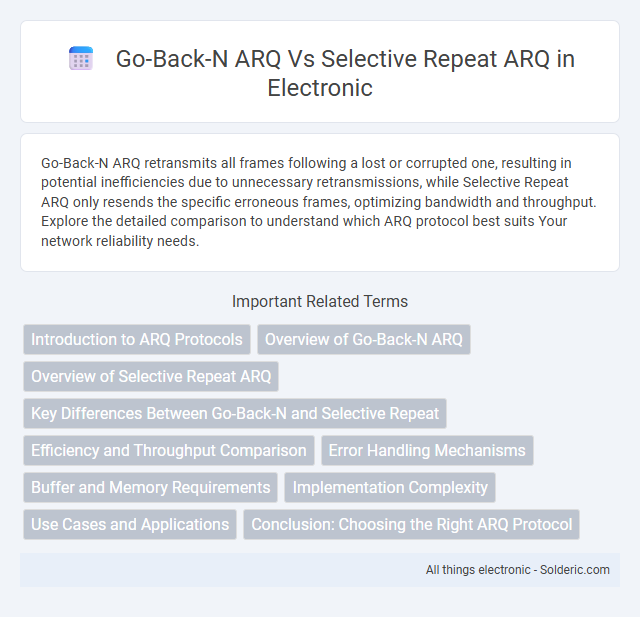Go-Back-N ARQ retransmits all frames following a lost or corrupted one, resulting in potential inefficiencies due to unnecessary retransmissions, while Selective Repeat ARQ only resends the specific erroneous frames, optimizing bandwidth and throughput. Explore the detailed comparison to understand which ARQ protocol best suits Your network reliability needs.
Comparison Table
| Feature | Go-Back-N ARQ | Selective Repeat ARQ |
|---|---|---|
| Error Handling | Retransmits all frames from erroneous frame onwards | Retransmits only erroneous frames |
| Window Size | Sender window size up to N, receiver window size 1 | Sender and receiver window size up to N/2 |
| Acknowledgment Type | Cumulative acknowledgments | Individual acknowledgments |
| Buffer Requirements | Low; receiver stores only next expected frame | High; receiver buffers multiple out-of-order frames |
| Efficiency | Lower with high error rates due to bulk retransmission | Higher efficiency by retransmitting only lost frames |
| Complexity | Simple implementation | More complex due to individual frame tracking |
| Use Case | Suitable for low-error environments | Preferred in high-error or lossy channels |
Introduction to ARQ Protocols
Automatic Repeat reQuest (ARQ) protocols ensure reliable data transmission by detecting errors and requesting retransmission of corrupted packets. Go-Back-N ARQ retransmits all frames from a corrupted packet onward, while Selective Repeat ARQ retransmits only the specific erroneous frames, optimizing bandwidth usage. Your choice between these ARQ protocols impacts network efficiency and overall error-handling performance.
Overview of Go-Back-N ARQ
Go-Back-N ARQ is a sliding window protocol used in data communication for reliable transmission by allowing multiple frames to be sent before requiring an acknowledgment. It operates by retransmitting all frames from a lost or erroneous frame onward, ensuring error detection but potentially causing higher bandwidth usage. Your network performance may be impacted by this approach due to increased retransmissions, especially in high-error environments.
Overview of Selective Repeat ARQ
Selective Repeat ARQ enhances error control in data transmission by allowing the receiver to acknowledge individual packets, enabling the sender to retransmit only those packets that are lost or corrupted. This protocol improves bandwidth efficiency and reduces latency compared to Go-Back-N ARQ, which requires retransmission of all subsequent packets after an error. Your network performance benefits from Selective Repeat ARQ's ability to handle multiple outstanding frames simultaneously while maintaining accurate error correction.
Key Differences Between Go-Back-N and Selective Repeat
Go-Back-N ARQ retransmits all packets following a lost or corrupted packet, leading to potential inefficiency in high-error environments, whereas Selective Repeat ARQ retransmits only the specific erroneous packets, optimizing bandwidth utilization. Go-Back-N requires a single timer for the oldest unacknowledged packet, while Selective Repeat maintains individual timers for each unacknowledged packet, increasing complexity but improving reliability. Your choice between these protocols impacts network performance, especially in terms of throughput and error recovery efficiency.
Efficiency and Throughput Comparison
Go-Back-N ARQ retransmits all frames after a lost or erroneous frame, which lowers efficiency and throughput due to redundant transmissions. Selective Repeat ARQ resends only erroneous frames, improving bandwidth utilization and increasing throughput, especially over high-latency or error-prone networks. Your choice between these protocols impacts network performance based on error rates and delay characteristics.
Error Handling Mechanisms
Go-Back-N ARQ handles errors by retransmitting all frames starting from the erroneous one, causing potential redundancy and increased bandwidth usage during high error rates. Selective Repeat ARQ improves error handling by retransmitting only the specific frames detected as erroneous, enhancing efficiency and reducing unnecessary data transfer. Your choice impacts network performance, with Selective Repeat offering better bandwidth utilization in noisy environments due to targeted retransmission.
Buffer and Memory Requirements
Go-Back-N ARQ demands less buffer memory since the sender only needs to store unacknowledged frames, while the receiver typically requires a single frame buffer, enabling a simpler design. Selective Repeat ARQ requires larger memory buffers at both sender and receiver ends because it stores multiple outstanding frames and individually acknowledges each, enhancing reliability and efficiency. Your choice between the two protocols should consider available memory resources and the desired throughput for optimal performance in communication systems.
Implementation Complexity
Go-Back-N ARQ features simpler buffer management and acknowledgment processes, making its implementation less complex compared to Selective Repeat ARQ, which requires maintaining multiple buffers for out-of-order frames and more sophisticated acknowledgment tracking. Selective Repeat ARQ demands additional memory and logic to handle selective retransmission, causing a higher implementation overhead in both sender and receiver. The complexity in Selective Repeat ARQ increases with window size, as each frame within the window must be individually tracked for successful delivery.
Use Cases and Applications
Go-Back-N ARQ is ideal for simpler systems with limited memory and low error rates, such as satellite communication and real-time multimedia streaming, where timely delivery outweighs retransmission efficiency. Selective Repeat ARQ is better suited for high-error environments like wireless LANs and mobile networks, providing superior bandwidth utilization by retransmitting only erroneous frames. Your choice depends on balancing system complexity against network conditions and performance requirements.
Conclusion: Choosing the Right ARQ Protocol
Go-Back-N ARQ offers simplicity and efficiency in low-error environments by retransmitting a single window of frames, reducing protocol complexity. Selective Repeat ARQ enhances bandwidth utilization and reduces unnecessary retransmissions, making it ideal for high-latency or error-prone networks. Selecting the right ARQ protocol depends on factors like error rates, network latency, and processing capabilities to optimize performance and resource use.
Go-Back-N ARQ vs Selective Repeat ARQ Infographic

 solderic.com
solderic.com